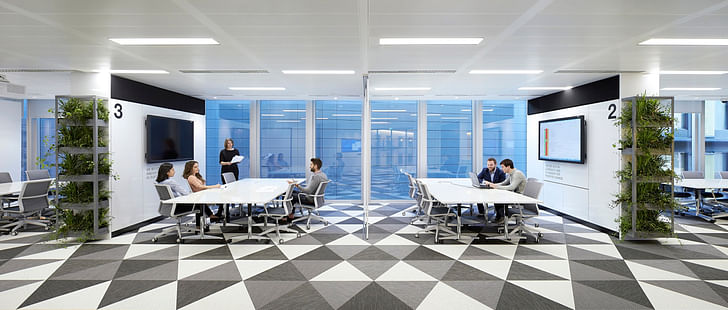

Workplace designers are changing their approaching to client spaces within the office.
Traditionally, clients occupied dedicated and contained spaces that are segregated from staff areas and amenities. These spaces are designed as microcosms for meeting and entertaining, often with higher levels of finishes and with the best views. A carefully planned sequence of arrival spaces and ‘protected routes’ guide clients to these areas, which would often be the only spaces visitors see.
This is changing: the line between client and staff space (between “back of house” and “front of house”) is dissolving. Carefully choreographed work environments – where staff and clients work side-by-side – are used to "open the front door", showing clients the working culture of the organisation and driving an appropriate shift to informality.
The office has become not just a space to pitch to your clients, but also an area where businesses can collaborate with them for longer periods of time. This is based on adding variety to the client experience, with spaces that are formal or informal, closed or open. This rise of more flexible and relaxed environments has been proven to forge closer bonds with clients whilst boosting efficiency and increasing utilisation.
We anticipate that the way in which organisations accommodate clients within their office will continue to shift
By virtue of sharing, these open and more inclusive working environments become social spaces where informal introductions can be more easily made, creating opportunities for clients to meet other members of the team from different parts of the business. This more relaxed and open approach also benefits staff, as the flexible spaces they have access to will have better facilities, finishes and usually a higher standard of fit-out.
It is not just young tech companies adopting these workings patterns; we have been working with several banks, solicitors and professional service providers on trying to achieve a more vibrant and flexible client experience. ID:SR Sheppard Robson has recently completed the new London office for the Commonwealth Bank of Australia (CBA), where a key element of the project brief was to boost collaboration, between internal teams and also with clients.

The key to this was creating a more relaxed environment for the bank’s team and clients to collaborate. This resulted in designing a dedicated space for an “innovation lab”, an open and flexible series of work settings that was specifically designed to move away from a ‘pitch’ setting and support longer periods of collaborative working.
There are stringent requirements for privacy at CBA, with the design including a range of meeting rooms and a boardroom. However, acknowledging a requirement for communicating with clients in numerous ways, the formal meeting spaces could not be static. They are designed as a series of private meeting rooms that can open-up to create one large space, connecting to the reception to form an even larger area for events.
This did not pigeon-hole the space as either for clients or staff and wanted to create a design that had the potential to transform the nature of the space from private to social in a matter of minutes. The major factor here is bringing large groups of people together; this could be for clients, staff or a mixture of the two. This social infrastructure enabled CBA to host events within their office rather than hiring external venues, putting the company’s brand and ways of working centre-stage.
It is likely that these flexible spaces will require a greater level of investment up front, as the furniture and fittings for flexible spaces do have a cost-premium attached. However, once created, these assets will be able to work harder and be inherently more agile.
Privacy is still fundamental to the way offices work and we certainly don’t see a move to purely informal and social spaces. However, we anticipate that the way in which organisations accommodate clients within their office will continue to shift, with variety and agility being the cornerstones of successful offices.
Robert joined Sheppard Robson in 2002 and was made a partner in 2014. He has worked on a variety of projects in the Project Leader role, delivering high quality solutions for a significant range of occupiers. He has extensive experience in workplace design, strategic consulting and project ...
No Comments
Block this user
Are you sure you want to block this user and hide all related comments throughout the site?
Archinect
This is your first comment on Archinect. Your comment will be visible once approved.